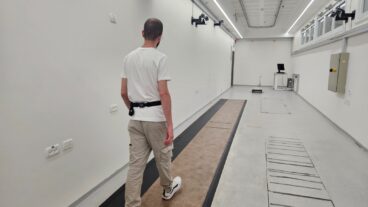Sleep studies by researchers at other hospitals support the Technion’s findings about post-traumatic sleep loss.After Sept. 11, requests for sleep medications had increased about 30 percent in New York City, while 23 percent of Americans nationwide said they had been suffering from insomnia. But, in fact, many trauma survivors sleep much better than they think they do, according to a report in the New England Journal of Medicine by Dr. Peretz Lavie of the Technion-Israel Institute of Technology.
The report, “Sleep Disturbances in the Wake of Traumatic Events,” by Lavie, an influential sleep researcher and head of the Sleep Laboratory at the Technion, also questions the traditional treatment for traumatized patients, which is based on reliving the trauma. Lavie’s studies with Holocaust survivors suggest that learning to leave traumatic memories behind may be more effective for a good night’s sleep.
The report is based on decades of research in the United States and on Israel’s population, “one of the world’s best laboratories for sleep studies given the numerous traumatic experiences this population has experienced,” Lavie said.
“In his report, Dr. Lavie finds that many of the sleep-related symptoms that are considered by some to be hallmarks of (post-traumatic stress) disorder seem to be without much basis in the laboratory and literature,” said Dr. Thomas D. Hurwitz, director of the Sleep Medicine Clinic at the Minneapolis VA Medical Center and assistant professor at the University of Minnesota Medical School.
Lavie’s studies on patients who complained about sleep problems indicate that “far fewer sleep disturbances are documented than would be expected among traumatized patients. People often confuse fear of going to sleep with inability to sleep, and also have misperceptions about the quality of their sleep,” Lavie said. “This is borne out by objective results from our sleep laboratory studies. On the other hand, many studies that show widespread sleep disturbances are based on subjective reports from patients.”
Two of many studies cited bolster Lavie’s findings that reported sleep loss is exaggerated. Researchers at the Minneapolis Veterans Affairs Medical Center used polysomnography (brain wave recordings) to analyze sleep patterns of 28 Vietnam veterans, 18 of whom had post-traumatic stress disorder. The 1998 study found participants consistently underestimated their sleep time and overestimated how long they took to fall asleep.
Lavie’s study monitored sleep patterns among 70 adults and children in areas of Israel under attack by Iraqi missiles during the 1992 Gulf War. By fitting participants with devices that monitor movement during sleep, researchers found surprising results: on average, participants slept normally. Even those wakened by the alarms that preceded missile attacks returned to sleep within 12 minutes at most. In contrast, a nationwide telephone survey around the same time, based on participants’ own descriptions, found a significant increase in sleep disturbances.
The vast majority of those suffering from sleep disorders following the terrorist attacks in New York and Washington will have only transient symptoms, a normal reaction to traumatic events, Lavie said. However, since sleep disturbances are often precursors to PTSD, Lavie advocates timely treatment of sleep disorders because that can often prevent the onset of PTSD or lessen its symptoms.
Lavie also advocates a treatment diametrically opposed to the currently popular treatment, which involves repeated recounting or reliving the traumatic event to help “master” the fear. His studies with Holocaust victims and Israeli war veterans support his argument that quickly moving beyond memories of traumatic events can actually be healthier for many people.
In a 1991 study of Holocaust survivors, Lavie found that better-adjusted survivors tended to remember fewer dreams than their less-well-adjusted peers. The dream recall rate for sleepers awakened during the rapid-eye-movement stage of sleep – commonly associated with dreaming – was 33.7 percent for survivors deemed well adjusted and 50.5 percent for those deemed less well-adjusted. Among the control group it was 80 percent.
Similarly, a study of 3,000 middle- and high-school students in Oklahoma City found that the amount of exposure to television coverage of the bombing was one of the predictors of scores on a scale of post-traumatic stress symptoms. The more students were exposed to television images of the bombing, the higher their score for post-traumatic stress symptoms.
Furthermore, other studies have shown that “imagery rehearsal therapy” – in which patients practice the substitution of pleasant images for unpleasant ones – has helped reduce nightmares and improved sleep in sexual assault victims.
Regardless of the specific counseling methods used, Lavie said that real “sleep disturbances in traumatized patients should be treated as an independent clinical entity, with both behavioral and pharmacologic therapies.”












